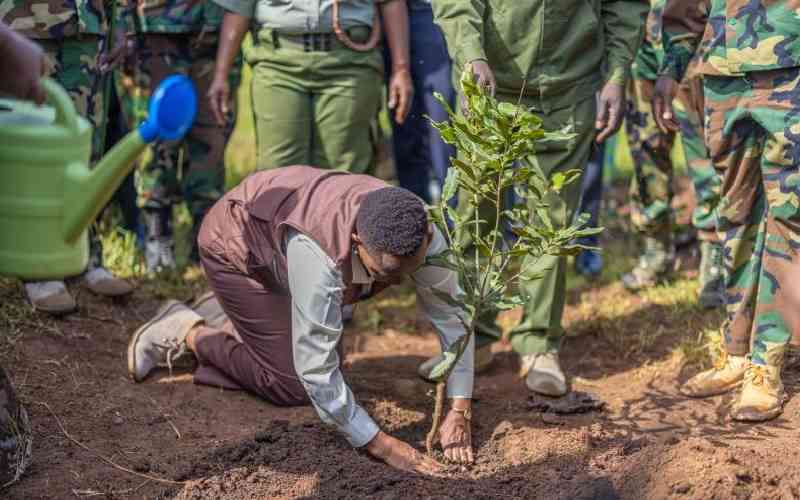Kakamega, Kenya: A popular tree in Kakamega Forest fondly known as Mama Mutere has fallen after 300 years. It fell weeks ago after its rotten roots could no longer support it.
According to the forest’s research education officer, Wycliffe Okeke, the tree started showing signs of dying a few years ago when it began losing its leaves and bark but remained upright.
“Even our fervent prayers could not save the old tree. We are very sad because some visitors had notified us that they were coming to see it,” said Okeke.
Mama Mutere was revered because it acted as a shrine where the local community went to pray to get blessings for rain and good harvest. Treasured also for its medicinal value, the famous tree was among the most photographed in Kenya’s remaining equatorial rainfall forest, says Okeke.
Kakamega Ecosystem Forest Officer Mwangi Muraguri says the tree has been a source of seeds and rain for the local community.
“The tree has left a legacy and even after it fell, some tourists still pay to come and view it,’’ noted Muraguri.
He said just like Kenya Wildlife Service has the big five, Kenya Forest Service also has a few unique trees, which included Mama Mutere.
“Some locals even worshiped it and claimed it was their grandmother,” he added.
Muraguri refuted claims of bad omen when a tree of that significance falls, saying they were not expecting any negative happenings.
Instead the forest management is looking to benefit from the attention the famous tree is creating.
“We are expecting more tourists to come and pay homage to the fallen tree. A bull will be slaughtered to give it a warm send-off,” Muraguri said.
KFS has made arrangements for locals who held Mama Mutere in high esteem to come to the forest anytime to pay their last respects on condition they don’t interfere with the eco-system.
“A tree like this coming down was critical to some of us because it demonstrates a number of issues about forests,” said Prof Kingiri Semelwa, a lecturer of renewable energy and climate change at Eldoret University.
Semelwa reiterated that the tree could have fallen down due to the short range of its tap roots and termites destroying the roots system.
It has not been fully decided what KFS and the local community will do with the tree. Some suggest that pieces of the tree be cut and preserved as souvenir with the rest remaining to form humus for growth of other trees.
Stay informed. Subscribe to our newsletter
However, others are of the view that the tree be left in its present state so that tourists and other people visiting the forest can see it until it fully decomposes.
Mama Mutere was part of the unique ecosystem of Kakamega Forest, a remnant of the unique Guineo-Congolian rainforest belt that once stretched along the equator across the entire expanse of Africa.
The forest resembles the rainforest of Central and West Africa much more than any other forest type in East Africa, and is home to more than 350 species of trees.
The forest is the main source of traditional medicines for the locals who use various roots, leaves and barks to cure all kinds of illness.
Due to constant and even distribution of rainfall in the western region, the forest also provides a constant supply of vegetables such as jute leaves (murere), spider plant (tsisaka) and black nightshade (tsimboka), among others.
Locals also harvest termites during rainy seasons from the forest, which is also the main source of firewood and timber.
 The Standard Group Plc is a
multi-media organization with investments in media platforms spanning newspaper
print operations, television, radio broadcasting, digital and online services. The
Standard Group is recognized as a leading multi-media house in Kenya with a key
influence in matters of national and international interest.
The Standard Group Plc is a
multi-media organization with investments in media platforms spanning newspaper
print operations, television, radio broadcasting, digital and online services. The
Standard Group is recognized as a leading multi-media house in Kenya with a key
influence in matters of national and international interest.
 The Standard Group Plc is a
multi-media organization with investments in media platforms spanning newspaper
print operations, television, radio broadcasting, digital and online services. The
Standard Group is recognized as a leading multi-media house in Kenya with a key
influence in matters of national and international interest.
The Standard Group Plc is a
multi-media organization with investments in media platforms spanning newspaper
print operations, television, radio broadcasting, digital and online services. The
Standard Group is recognized as a leading multi-media house in Kenya with a key
influence in matters of national and international interest.






